
Dissecting the Walrus
Atlas F1 Technical Writer
The Williams team launched this week their FW26, one of the most radical-looking Formula One cars for some time, its walrus-style front wing causing a lot of stir when the new machine was unveiled to the public. Atlas F1's Technical Writer Craig Scarborough takes a closer look at Williams's 2004 revolutionary challenger
2004 Rules
Aside from the timetable changes to the practice and qualifying sessions there have been few technical changes for 2004, and of these the most far reaching has been the move to a single engine per weekend format. Under previous rules precautionary engine changes were made overnight or following a failure, resulting in up to a handful of engine being used per car over a race weekend. Most of the teams support the FIA suggestion that a single engine could be used to reduce costs, applying a "10 grid place" penalty to any car requiring an engine change over the weekend. This doubling of engine life (now up to 800Kms) has put a great strain on the engine designers.
For the chassis engineers a few aerodynamic changes have been made; the rear wing has been regulated to have only two upper elements rather than the previous three (excluding the lower beam), and the endplate has been enlarged. Following Ferrari's move to shrink the lead engine covers to such an extent that they no longer met the dimension maximum this cover must now meet the imaginary line drawn up from the rear axle line. Away from aerodynamics the chassis impact tests have been incremented, forcing the structures departments to work harder to get the structure both safe and light.
I am the Walrus
At first glance the new nose is both dramatic and ugly; brutal perhaps. Williams have gone so far from convention that the team will need more time to fully understand its effect. Technical director Patrick Head was adamant there were gains from the set up despite Frank Williams admitting "its not very pretty" and that it did lose some valuable advertising space on the nose.
Aerodynamics is dominated by the flow coming from the front of the car, by the way the flow passes over the front wing, between the front wheels and around the centre of the car. The way this is all affected by the attitude of the car to the road is critical. New wing shapes, high noses, bargeboards and twin keels are all well developed solutions to manage this flow. Antonia Terzi, the team's head of aerodynamics, sought to eliminate the part of the nose above the front wing, allowing more freedom for the flow both over and below the car and in contrast to the Ferrari / McLaren approach to actively use the underside of the nose cone to interact with the wing.
In shortening the nose cone the need to still mount the front wing remained. The dagger shaped pylons lead forward from the truncated nose to meet the front wing, which is largely the same the "W" concept adopted in 2003, yet now the wing is in almost free air. Williams retained a derivative of their forward mounted turning vanes, and the front wing mounting pylons match their curve, appearing to guide the flow from the front wings dipped sections between the wheels and out through the turning vanes. This keeps the flow under and over the wide nose to efficiently feed the sidepods and rear wing; the pylons extend up the nose to form a fence keeping this flow from spilling along the sides of the car too early.
The twin keel could be considered a design concept best matched to the dipped wings of 2001-2003 and not so relevant with the "W" format wings increasingly adopted on the late 2003 cars. With the square cross section of the nose now placing more importance on the upper and lower surfaces, twin keels have been adopted to move the suspension mounts away from the wide flat under nose shape. Curiously the keels are not in line with the pylons, as perhaps Jordan have adopted. Yet the Williams solution matches the slim form of the Jordan layout to the length and angle of the McLaren.
Patrick Head further commented that the set up subtly improves the aerodynamic map, where the car's downforce changes little with changes in pitch, roll or yaw. Indeed the side profile of the nose is considerably smaller in surface area to a conventional nose, probably aiding turn-in or yaw resistance yet further.
Structures
Equally the nose has proven to be a structural nightmare, as it is required to meet impact tests and decelerate the impact load in a controlled manner, never exceeding certain G levels. This is usually achieved over the much longer length of a conventional nose cone. Head explained the shorter nose was made to work "by the way it collapses and the length of that collapse" in order to meet the test requirements. Credit goes to Brian O'Rourke, Williams head of composites, who has use of a secret impact test facility within the Williams factory to get the nose to accept the 3/4 ton load in a controlled crumple. One issue raised with the new nose was the potential for the pylons to penetrate a competitor's car in a side impact; simulations and physical tests were carried out to ensure they broke away safely.
Mechanical Layout
Williams went against their previous practice of long wheelbases last year and adopted a short layout, largely through a smaller gearbox and fuel cell. This year the fuel cell has had a small decrease in capacity, with Williams appearing to place the smaller volume lower, rather than forming a shorter or narrower fuel tank. Also affecting the wheelbase is the engine and gearbox; Mario Theissen of BMW noted that the engine was slightly smaller while Patrick Head said the gearbox has gone up from six to seven speeds, yet the extra ratio has been packaged within the same length.
Overall the car retains a very similar wheelbase to the FW25. Seven speeds were adopted this year not so much because of the powerband of the BMW P84 engine but rather to give the range of ratios throughout the weekend; the team will be using lower revs on Friday and Saturday morning to preserve the single engines life. Additionally Head said the new aluminum cased gearbox was "lighter than last year, smaller and much clean aerodynamically down the sides", and it was sand cast in the same BMW plant in Landshut, Germany as the engine. The partnership between BMW's engineering and production teams with those at Williams also extends to the initial "rapid prototyping" of the casings and manufacture of gears, cranks and camshafts.
Torsion bars on the front have been mounted incrementally lower than on the FW25, and they extend longer to allow for more wheel travel. The steering rack has moved inside the footwell of the monocoque, probably for impact protection, rather than being bolted to its front. With more forward weight bias (around 46%) being the demanded from the tyres and this year's wheel base remaining constant, placing any other masses forward has been a issue. So as with Ferrari, Williams appear to have used the splitter as housing for a considerable amount of ballast, choosing to double skin the knife-edge and fill it out with slabs of metal to bring weight forward.
Other Aerodynamics
While it is not possible to separate the effect of one aerodynamic component without looking at the rest, the balance of the cars aerodynamic detail is described away from the attention-grabbing nose. As explained in the earlier paragraph the "Walrus" nose works with the turning vanes and front wing pylons, acting to divert the powerful flow from the dipped wing section away from the centre of the car, improving the quality of the flow to the sidepods for cooling and the rear wing and diffuser for downforce.
While now mounted to the keel rather than a dedicated strut the two panel turning vanes adopt a similar shape to the FW25, but doesn't use a double aerofoil on the vertical leading edge. The vertical fences on the side of the front splitter remain, as does a more rounded horizontal fin (now dubbed "water-wings" at BAR) ahead of the sidepod. The sidepods themselves house revised radiators, but the distinctive low shape is retained over Ferrari's compact philosophy. One subtle revision is to the leading edge of the sidepods, now much squarer than the fare in design of the FW25.
Back along the sidepods the launch car sported familiar flip ups, exhausts, chimneys and asymmetric winglets, all of which may be revised in detail before Melbourne. Covered up on the launch car but visible when on track the diffuser follows yet more familiar territory, with tall square tunnels and a raised outer floor section between the main diffuser and wheels. As demanded by the regulations the rear wing sported bigger endplates and two upper elements. The two elements were of a simple 2D profile and not the complex layout seen in 2003; this will no doubt come in time, but the launch wing with its steep rear flap and large slot between the elements is probably on the high end of the downforce spectrum. The lower wing beam adopted a highly curved shape as it acts to reduce vortices created at the junctions with the taillight and endplates, and works in conjunction with the diffuser in its middle sections.
800Km Engine
With the 2003 engine revving to 19,200rpm, producing upward of 900bhp and weighing at less than 100Kg (probably nearer 90Kg), the three-litre V10 formula was at its peak. When the one engine rule was announced BMW's Motorsport director and designer Heinz Paschen was unsurprisingly worried, and initially expected big drop in revs and increase in weight.
These moving parts lives were extended using detail design and some material or surface treatments; a lot of that was only possible with computer simulation to assess the detail changes. As usual the BMW engine programme was run well ahead of time; the components were tested before July and then run on to the dyno, with the complete engine in a car for the first time before the Monza GP; one P84 engine has run at every test since. Theissen did however add there was more work to be completed before Melbourne, as they were not all the way there yet.
Even though McLaren ran their new car in December testing their decision not to formally launch the car gave Williams BMW the chance to put on their new suits (and boots) and be the first to present their car to the world's media.
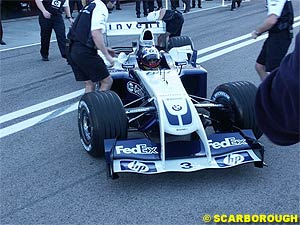 For several years Williams have produced evolutionary cars and, with engine rule changes and a car that by the seasons end in 2003 was as fast as any, little was expected to surprise on the new car. But this was wide of the mark; as the cover was drawn from the car the sharp intake of breath from the audience reflected the striking nose of the new car. Clearly Williams conventional, if independent, school of aerodynamics has found a completely new solution. Although the nose rightly takes the spotlight, other areas of the car remain conservative, with some areas revised and not receiving the attention they perhaps deserve.
For several years Williams have produced evolutionary cars and, with engine rule changes and a car that by the seasons end in 2003 was as fast as any, little was expected to surprise on the new car. But this was wide of the mark; as the cover was drawn from the car the sharp intake of breath from the audience reflected the striking nose of the new car. Clearly Williams conventional, if independent, school of aerodynamics has found a completely new solution. Although the nose rightly takes the spotlight, other areas of the car remain conservative, with some areas revised and not receiving the attention they perhaps deserve.
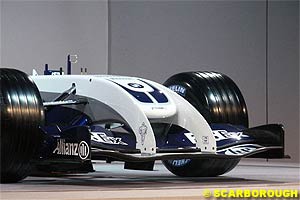 But in order to gain a greater step in aerodynamic performance the team researched this approach soon dubbed the "Walrus" by journalists at the launch. The aim to maximise downforce, minimise drag and satisfy cooling demands lead the team to run aerodynamic studies, starting with computer based CFD studies before moving onto the wind tunnel for the more promising solutions.
But in order to gain a greater step in aerodynamic performance the team researched this approach soon dubbed the "Walrus" by journalists at the launch. The aim to maximise downforce, minimise drag and satisfy cooling demands lead the team to run aerodynamic studies, starting with computer based CFD studies before moving onto the wind tunnel for the more promising solutions.
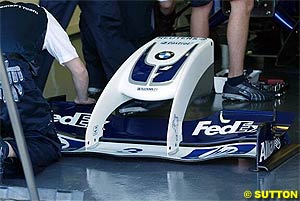 With the research to get the odd-looking aerodynamic concept proven and accepted by the management completed, work started on getting the nose and keels structurally sound. Head admitted that twin keels were investigated by Williams before with some aero gains, but were offset by the structural penalties. With a "Walrus" concept the aero gains in twin keels were much greater, and countered the weight penalty of the structure to support what Head described as "an off axis load from the very highly loaded forward leg of the front wishbone".
With the research to get the odd-looking aerodynamic concept proven and accepted by the management completed, work started on getting the nose and keels structurally sound. Head admitted that twin keels were investigated by Williams before with some aero gains, but were offset by the structural penalties. With a "Walrus" concept the aero gains in twin keels were much greater, and countered the weight penalty of the structure to support what Head described as "an off axis load from the very highly loaded forward leg of the front wishbone".
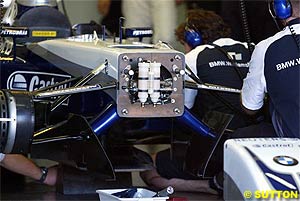 Clearly visible from the mould lines on the front bulkhead, the monocoque has been moulded from three majors pieces; a lower tub, then two left and right mouldings to form the upper two thirds of the car. Internal bulkheads are visible through the footwell, but this does not rule out the lighter option of a largely bulkhead-less design. Elsewhere the chassis is considerably stronger, especially along the cockpit sides, while being lighter than last year. The other crash structures at the side and rear of the vehicle have been improved.
Clearly visible from the mould lines on the front bulkhead, the monocoque has been moulded from three majors pieces; a lower tub, then two left and right mouldings to form the upper two thirds of the car. Internal bulkheads are visible through the footwell, but this does not rule out the lighter option of a largely bulkhead-less design. Elsewhere the chassis is considerably stronger, especially along the cockpit sides, while being lighter than last year. The other crash structures at the side and rear of the vehicle have been improved.
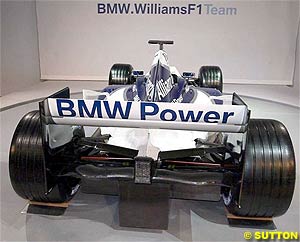 Along with a revised gearbox, the rear suspension uses a McLaren-like layout. Placing the rear leg of the upper wishbone very high and the forward leg very low, plunging through the bodywork just behind the flip up, the damper and torsion bar layout have been further refined form 2003 with little shaping required on the slim engine cover to hide the innards. Up front the wishbone layout further progresses on William's previously horizontal upper wishbone, which now appears to droop, creating an unusual geometry leaving the experts to discuss the merit of its camber control and roll centre location.
Along with a revised gearbox, the rear suspension uses a McLaren-like layout. Placing the rear leg of the upper wishbone very high and the forward leg very low, plunging through the bodywork just behind the flip up, the damper and torsion bar layout have been further refined form 2003 with little shaping required on the slim engine cover to hide the innards. Up front the wishbone layout further progresses on William's previously horizontal upper wishbone, which now appears to droop, creating an unusual geometry leaving the experts to discuss the merit of its camber control and roll centre location.
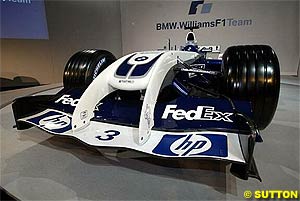 The front wing adopts a similar span and profile to those seen in 2003, except perhaps for the middle section being wider and flatter. It was the endplates that saw another divergence by Williams; the wavy lip along the lower edge of the endplate is almost universally adopted in the pit-lane to improve sealing under the endplate and reduce vortex creation. Williams adopt a "h" profile where the lip forms a channel in cross section, it also feature a semi bell mouth shape at its front and a diverging shape toward the rear.
The front wing adopts a similar span and profile to those seen in 2003, except perhaps for the middle section being wider and flatter. It was the endplates that saw another divergence by Williams; the wavy lip along the lower edge of the endplate is almost universally adopted in the pit-lane to improve sealing under the endplate and reduce vortex creation. Williams adopt a "h" profile where the lip forms a channel in cross section, it also feature a semi bell mouth shape at its front and a diverging shape toward the rear.
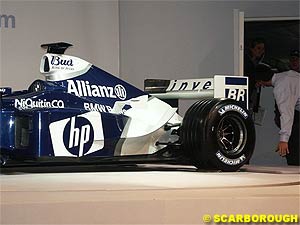 The airbox and engine covers are much slimmer this year, and are preceded by a much slimmer squarer cockpit treatment. The trailing edge of the engine cover above the airbox now needs to meet a minimum width; Williams have achieved this by wrapping the cover as tightly as possible around the airbox before pinching the top 5cm into the absolute minimum permitted shape.
The airbox and engine covers are much slimmer this year, and are preceded by a much slimmer squarer cockpit treatment. The trailing edge of the engine cover above the airbox now needs to meet a minimum width; Williams have achieved this by wrapping the cover as tightly as possible around the airbox before pinching the top 5cm into the absolute minimum permitted shape.
 As the project took off and the teams investigated the requirements to make the 800km engine it became clear some components were up to the job. The engine casings and heads were fine, but it was the reciprocating parts that needed attention to keep from breaking under their immense loads for twice the amount of time. Pistons, con-rods and valve trains were the big challenge to get down in weight and size, and Theissen noted the team's success in this area, commenting that "surprisingly little extra weight" was added to keep the overall weight in the same area.
As the project took off and the teams investigated the requirements to make the 800km engine it became clear some components were up to the job. The engine casings and heads were fine, but it was the reciprocating parts that needed attention to keep from breaking under their immense loads for twice the amount of time. Pistons, con-rods and valve trains were the big challenge to get down in weight and size, and Theissen noted the team's success in this area, commenting that "surprisingly little extra weight" was added to keep the overall weight in the same area.
Please Contact Us for permission to republish this or any other material from Atlas F1.
|
Volume 10, Issue 01
Articles
Williams Launch: Reading Between the Lines
Ugly is Beautiful for Williams
Technical Analysis: Dissecting the Walrus
Interview with Hermann Tilke
2004 Countdown: Facts & Stats
Columns
The Fuel Stop
On the Road
Elsewhere in Racing
> Homepage |